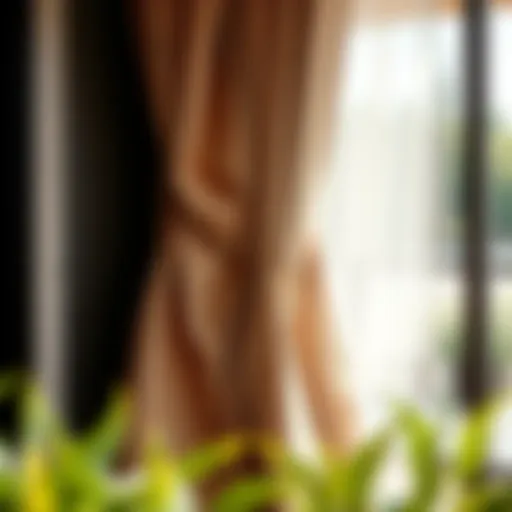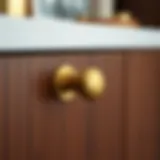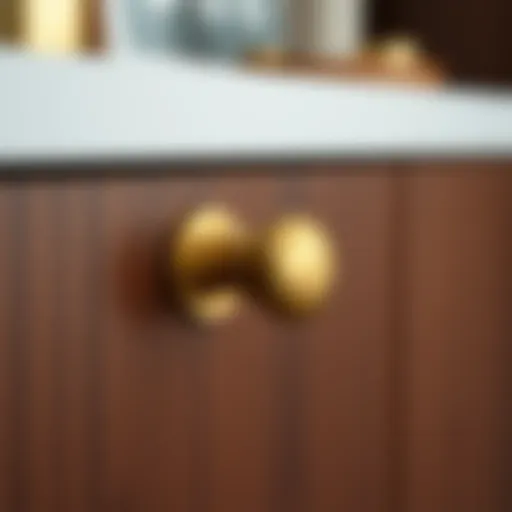Discovering the Benefits of Faux Wall Room Dividers


Intro
In the realm of interior design, the concept of dividing spaces has evolved significantly, especially with the rise of faux wall room dividers. These innovative elements serve not just a functional purpose, but also stimulate aesthetic appreciation. As modern homeowners and designers look to maximize their living spaces without major renovations, faux dividers emerge as a solution that blends versatility and style. This guide embarks on an exploration of these dividers, highlighting their practicality, aesthetic appeal, and adaptability in a variety of settings.
Faux wall room dividers can be crafted from an array of materials, including wood, metal, glass, and even fabric. Their adaptability allows them to cater to different design esthetics—from minimalist to bohemian—providing users with myriad options to fit their decor. By the end of this article, readers should have a solid understanding of the distinct styles, applications, and benefits that these unique room dividers can integrate into their homes, allowing for the creation of dynamic and functional spaces.
Design Trends
As we move through contemporary design landscapes, it’s vital to recognize how emerging trends shape the use of faux wall room dividers, making them not just a choice, but a statement piece in any home.
Current Trends in Furniture Styles
The line between functionality and artistry is blurring. Faux wall dividers are stepping up to the plate, offering homeowners the chance not only to partition areas but also to add a dash of character to otherwise plain rooms. Some trends noted in recent designs include:
- Natural Materials: The shift towards a more organic feel sees more homeowners opting for dividers made from reclaimed wood or bamboo, bringing in a touch of nature indoors.
- Artistic Screens: Featuring elaborate patterns and intricate designs, these movable pieces are as much about style as they are about function, allowing for personalization in every nook of your space.
- Multifunctionality: As homes continue to shrink in size, the demand for multifunctional furniture is skyrocketing. Faux wall dividers that can double as storage or display areas are becoming increasingly popular.
As such trends evolve, they capture not only the spirit of innovative design but also reflect the daily needs of modern living. Homeowners are migrating towards unique solutions that cater to personal style while enhancing their surroundings.
How to Incorporate Trends into Your Space
Integrating these stylish trends into your home requires some thought and creativity. Here are a few strategies that can be effective:
- Consider Your Space: Assess the flow and function of each room before selecting a divider. For example, a tall, open wood screen can complement higher ceilings and wider rooms, while a low metal divider suits cozier settings.
- Blend with Existing Design: Choose dividers that resonate with your current decor. If your home exudes a modern vibe, opting for sleek metal patterns keeps the look consistent.
- Play with Color and Texture: Faux wall dividers offer a canvas for creativity. Implement diverse materials like fabric or painted wood to introduce vivid colors or textures that elevate overall design.
- Light and Transparency: Consider incorporating transparent or semi-transparent materials like glass or acrylic. These allow light to filter through, ensuring spaces remain bright and inviting without sacrificing division.
By thoughtfully selecting from these trends, homeowners can create captivating, functional spaces that embody their personality and lifestyle.
"Faux wall dividers can transform a single room into multiple functional areas, ensuring that spaces work harder without losing character."
This exploration paves the way for a deeper understanding in the next sections, where we'll dive into buying guides and practical advice on selecting and maintaining these unique features.
Prologue to Faux Wall Room Dividers
Faux wall room dividers represent an innovative approach to defining spaces in both residential and commercial settings. Their growing importance in contemporary design warrants a closer look. These dividers do not only serve as functional barriers, but they also contribute prominently to the aesthetic narrative of a space, making them an appealing option for homeowners, designers, and DIY enthusiasts alike.
Definition and Purpose
Faux wall room dividers are crafted from various materials that mimic the look and feel of traditional construction but with the added advantage of flexibility. In essence, these dividers can alter a room’s configuration without the permanence of a structural wall. The purpose is twofold: to segment areas for different functionalities and to enhance the overall visual appeal. For instance, a faux wood divider can transform a spacious living area into a cozy nook for reading or entertaining. The utility of these dividers lies in their adaptability — they can be rearranged, removed, or replaced as one’s needs evolve.
The trend is particularly beneficial in urban living situations where space is at a premium. People can create separation between work and leisure zones, thus boosting productivity while maintaining a comfortable home life.
The Rise in Popularity
In recent years, faux wall room dividers have seen a surge in popularity. This can be attributed to a few key factors including changing lifestyles and technological advancements in manufacturing processes. As more individuals opt for open-concept designs, the need for visually appealing yet functional dividers has become evident. Homeowners are increasingly seeking solutions that allow them to customize their spaces without undertaking costly renovations.
Moreover, as consumers become more environmentally conscious, the demand for sustainable materials in interior design has also propelled the popularity of faux dividers. Materials such as recycled composites or sustainably sourced wood are not only cost-effective but align with the eco-friendly ethos many individuals embrace today.
Furthermore, the creative design possibilities are virtually limitless. From sleek, contemporary looks to rustic charm, faux wall dividers can complement any interior design style. This adaptation is not only practical but also invigorates spaces by helping individuals express their personal style.
"Faux wall dividers are not just functional tools; they are also artistic expressions that enhance living environments."
In summary, the rise of faux wall dividers is tied to their multifaceted benefits, aligning with modern sensibilities towards space management and aesthetic expression. As more people discover their advantages, these elements are likely to become staples in both homes and businesses alike.
Types of Faux Wall Room Dividers
Faux wall room dividers are a popular solution among homeowners and designers looking to optimize space, bring in style, or create distinct areas within broader rooms. The diversity in types of faux wall dividers opens doors for various applications and aesthetics, allowing individuals to choose a style that fits seamlessly into their environment. Each type has its own unique characteristics, advantages, and considerations that set it apart from others, making it crucial to explore these aspects.
Faux Wood Dividers
Faux wood dividers are often the go-to choice for those wishing to achieve a rustic or warm feel. They offer the beauty of natural wood without the hefty price tag and maintenance hassles associated with real timber. These dividers come in various finishes and grains, mimicking oak, walnut, or even reclaimed barn wood, providing visual interest for any room.
The installation of faux wood dividers can be relatively straightforward, allowing DIY enthusiasts to engage in a rewarding project. They can be constructed from composite materials, which are both lighter and more durable than traditional wood. This is particularly beneficial as these dividers are not just lightweight but are built to withstand the test of time.
Moreover, with faux wood, homeowners have more freedom to express their style. Whether you are trying to enhance an urban loft or a cozy cottage, faux wood options allow for customization using stains, colors, or textures that fit the desired ambiance.
Faux Glass Dividers
Faux glass dividers are superb for maximizing light while providing a sense of separation. They typically come in various forms such as frosted, clear, or textured glass, which can effectively diffuse light without sacrificing privacy. This is especially valuable in small spaces where natural light can make a room feel larger and more inviting.
These dividers often feature lightweight frameworks and can be designed with minimalistic or ornate styling, catering to both modern and traditional decor. Furthermore, faux glass dividers are easy to clean, which is a practical consideration for busy households or commercial spaces.
However, it’s worth noting that while faux glass can mimic the look of real glass, the quality of the material can vary significantly. Investing in higher-end options can ensure durability and aesthetic quality. Additionally, their installation may require a bit more skill or professional help, especially for intricate designs or larger configurations.
Fabric and Textile Dividers
Fabric and textile dividers introduce texture and softness into a space, making them an appealing choice for those wanting to add warmth or a touch of elegance. They can be draped or hung from a track system, allowing for flexibility in how the spaces are divided. Some trendy options include sheer drapes that flutter with the slightest breeze, and heavier fabrics that block sound and light, perfect for creating a cozy nook.
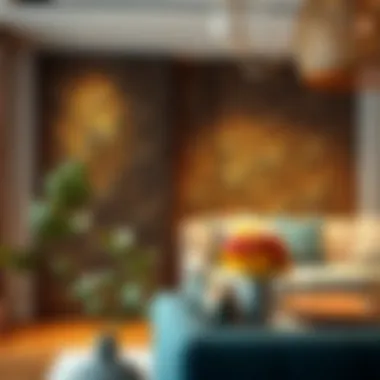

The advantages of using textile dividers include a wide range of designs, colors, and patterns available, which can easily complement or contrast with existing decor. Homeowners can utilize fabric remnants or recycle older textiles, making this not just a stylish but also a sustainable choice.
On the flip side, fabric dividers can demand more frequent maintenance when compared to wood or glass. They may require cleaning to avoid dust accumulation and to maintain their appeal. But, in settings where flexibility and style are critical, fabric dividers are an excellent choice.
"Faux wall room dividers, whether wood, glass, or fabric, serve not just as separators but as vital components in overall interior design, blending functionality with artful expression."
In summary, understanding the different types of faux wall room dividers is foundational to selecting the right solution for your space. Choices such as faux wood, glass, and fabrics cater to various aesthetic preferences and practical requirements, offering ample room for creativity and individual taste.
Materials Utilized in Faux Wall Room Dividers
The choice of materials in faux wall room dividers plays a critical role in shaping their overall functionality, aesthetics, and durability. Understanding which materials are utilized enables homeowners, designers, and enthusiasts alike to make informed decisions. By exploring material properties, benefits, and sustainability aspects, we can grasp how they contribute to the overall efficacy of these room dividers.
Faux wall room dividers can transform spaces, making them feel spacious or intimate. Choosing the right material also brings significant value, sometimes even saving costs in the long run.
Sustainable Materials
The movement toward sustainability is more than just a trend; it has taken center stage in many areas of design, including faux wall room dividers. Homeowners are increasingly interested in materials that have a minimal environmental impact. For example, bamboo is an excellent option due to its rapid growth and renewability. Its lightness and strength make it a popular choice for creating natural-looking dividers.
Additionally, reclaimed wood has become a favorite for those looking to add character while promoting sustainability. Using wood that has already served its purpose minimizes waste and reduces the demand for new lumber. These materials not only look good but also contribute positively towards a greener planet. They exhibit unique textures and colors that offer a rustic charm.
Some manufacturers also use eco-friendly finishes and water-based adhesives, which further enhance the sustainable profile. By opting for these materials, you not only achieve a stylish look but also a clearer conscience.
Innovative Composites
Innovative composite materials are another leap in creating functional and visually appealing faux wall room dividers. These composites often combine various materials to create a stronger, more versatile final product. For instance, many designs utilize engineered wood, which combines smaller wood pieces and adhesives to form sheets. This method reduces waste and provides greater strength and stability.
Moreover, composite materials can mimic natural elements like stone or wood, thanks to advanced printing technologies. These faux finishes reduce the reliance on natural resources while providing a similar aesthetic appeal. They also often come with added benefits such as improved moisture and fire resistance.
Using composites can lead to a more uniform look, especially when a clean or modern vibe is sought in a space. They can cater to a variety of design intents, making them an essential choice for both residential and commercial applications.
In summary, the materials utilized in faux wall room dividers not only dictate the functional aspects but also significantly influence the design narrative of a space. Sustainable options offer environmental benefits, while innovative composites elevate the versatility and adaptability of these unique structures. Understanding these materials arms a homeowner or designer with the knowledge needed to create spaces that align perfectly with both their aesthetic and practical needs.
Benefits of Faux Wall Room Dividers
Faux wall room dividers offer a range of advantages that appeal not only to homeowners but also to designers and DIY enthusiasts. Understanding these benefits is essential as it can aid in making informed decisions about enhancing living or working spaces. Allowing for improvements in functionality, aesthetics, and budget, faux wall dividers are increasingly becoming a favorite in various settings.
Flexibility in Space Management
One of the standout features of faux wall room dividers is their incredible flexibility. Unlike traditional wall installations, which can be a headache to modify or remove, faux dividers provide a dynamic approach to space management. Homeowners often find that these dividers allow them to easily create separate areas within larger spaces. For instance, you could transform a sprawling living room into a cozy reading nook or a functional home office by simply adding a faux divider.
Imagine you’ve got a small apartment. You can segment off your work area while still maintaining easy access to the kitchen without sacrificing open space. Additionally, they can be repositioned or removed with little effort, making rearranging a breeze.
"Flexibility is key when it comes to modern living; faux wall dividers are the perfect tool for adapting your space to suit your needs."
Aesthetic Enhancement
The eye-catching appeal of faux wall room dividers is beyond measure. They can be found in numerous designs, colors, and materials, allowing them to meld seamlessly into any decor style. Whether you opt for a faux wood divider that brings rustic charm or a sleek glass variant for a modern vibe, these dividers serve not just as functional pieces but also as decorative accents.
Consider how a faux brick divider can bring warmth and texture to an otherwise sterile room. Mixing and matching different materials can create a visually stimulating environment, making it as unique as the personality of its inhabitants. Thus, these dividers become an adept way of expressing style without extensive renovations.
Cost Efficiency
Last but not least, faux wall room dividers are a cost-effective solution for creating new spaces. Traditional room divisions often entail high costs due to construction and material needs. In contrast, faux dividers provide an economical alternative that doesn't skimp on style or function.
Whether it's setting up an impromptu office or crafting a reading alcove, the initial investment is minimal. They can be rented or purchased at various price points, making them accessible to a broad audience. Moreover, consider the long-term savings on renovation costs – since these dividers are easily movable and repositionable, decorating or re-configuring your space becomes less costly over time.
In essence, the benefits of faux wall room dividers extend beyond mere aesthetics, tying together functionality, style, and budget considerations. Embracing these dividers can result in spaces that are not only harmonious but also practical and reflective of individual taste.
Design Considerations
When diving into the world of faux wall room dividers, understanding design considerations is crucial. These elements not only influence the aesthetic appeal but also impact the functionality of a given space. With various styles, colors, and sizes to choose from, making informed decisions can enhance both the beauty and utility of your environment.
Style Cohesion with Interior Design
For a room divider to truly shine within a space, it must resonate with the overall style of the surrounding decor. This means assessing the existing design theme—whether it leans toward minimalist, contemporary, rustic, or eclectic. For example, a faux wood divider can beautifully complement a room decorated with natural elements while a sleek faux glass option may be more suitable for a modern, chic aesthetic.
Think about integrating patterns or textures that echo what’s already present in the room. If your furniture has curved edges, selecting a rounded divider might harmonize visually. This approach helps create a seamless flow, leading to a more cohesive atmosphere.
Color Schemes and Patterns
Color is a fundamental aspect of any design, and faux wall room dividers offer a remarkable opportunity to introduce new shades or to reinforce existing ones. Choosing a color that aligns or contrasts strategically with the overall color palette can create a focal point or enhance existing features. For instance, a soft beige faux wall divider might serve to warm up a room dominated by cooler tones.
When it comes to patterns, consider the function of the space. Highly decorative or busy patterns may distract in a calm, restorative area like a bedroom, whereas a vibrant design could energize a home office. It's essential to strike a balance, ensuring that the divider's color and pattern enhance rather than clash with the overall design scheme.
Size and Scale
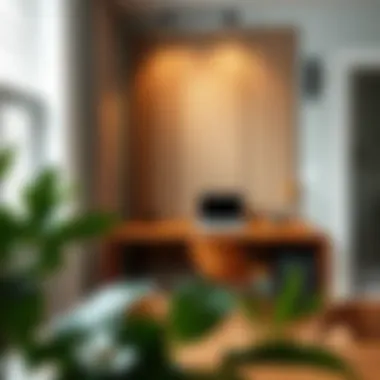

The size and scale of a faux wall room divider are pivotal considerations. A divider that is too big can overwhelm a space while one that’s too small might get lost in the room. Gauge the height and width based on the dimensions of the area and the furniture placement. For instance, if you have high ceilings in a loft-style apartment, a taller divider can create a grand statement and delineate spaces without feeling cramped.
Furthermore, consider the scale of the existing decorative elements. A delicate divider may be dwarfed by substantial furnishings, whereas a robust divider might dominate a more understated setup. Opting for a proportional divider not only ensures functionality but also elevates the design aesthetic.
In summary, when evaluating design considerations for faux wall room dividers, take into account how style, color, and size speak to the room's overall identity. This reflection leads to a more harmonious living space that delivers both beauty and practicality.
"Design is not just what it looks like and feels like. Design is how it works." - Steve Jobs
By integrating these considerations, you can effectively enhance the ambiance and functionality of your environment.
Installation Methods
Installation methods for faux wall room dividers can greatly influence how they fit into your space both functionally and aesthetically. Understanding these methods allows homeowners, designers, and DIY enthusiasts to make informed decisions. Depending on the preference for flexibility or permanence, installation can either be straightforward or require professional insight. Here, we will explore two distinct paths: DIY installation and professional services, weighing their pros and cons while offering useful tips.
DIY Installation Tips
For those who take pride in their handiwork, installing faux wall room dividers themselves can be a rewarding endeavor. Here are some essential tips to consider:
- Understand Your Space: Before you even think about tools, take a long hard look at the area you want to divide. Measure the space correctly and plan the layout on paper or even with floor tape.
- Choose the Right Materials: Materials can range from lightweight fabric to sturdy faux wood. Consider the installation surface as well—walls may require different fastening techniques compared to ceiling installations.
- Gather the Right Tools: A drill, level, measuring tape, and possibly a stud finder are foundational tools. If your divider needs anchoring, make sure you have wall anchors that suit.
- Follow Instructions Carefully: Many products come with installation instructions that can make the process smoother. Don’t skip reading them, even if they seem straightforward. Missteps can cost time and materials.
- Test Fit Before Finalizing: It’s wise to do a test fit. Hold the divider in place without fastening it down first, ensuring it aligns with your vision.
By following these guidelines, a DIY installer can both save money and enjoy the satisfaction of a job well done. Just remember—measure twice, cut once!
Professional Installation Services
On the flip side, choosing professional installation services offers a different kind of reassurance. It can promise a polished outcome paired with peace of mind. Here’s why you might consider going this route:
- Expertise and Experience: Professionals have likely installed variations of faux wall dividers many times before. Their experience can alleviate common pitfalls you might encounter when going solo.
- Quality assurance: When professionals handle the installation, there’s an assurance of quality. This is particularly important in commercial settings where aesthetics and durability are paramount.
- Time-Saving: A professional team can often complete installations in a fraction of the time it would take for a novice. If you're in a hurry to get your space set up, this can be a savvy choice.
- Customization Options: Professionals can often better assist with custom solutions tailored to your specific needs, such as configuring dividers for unique spaces or unusual room layouts.
If you opt for professional installation, be sure to vet suppliers, seeking reviews and perhaps even visiting previously completed installations to ensure their work aligns with your standards.
In the end, the right installation method for faux wall dividers will depend on your skills, timeline, and desired result. Whichever route you choose, both DIY and professional installation have their merits and deserve thoughtful consideration.
Maintenance and Care
Understanding maintenance and care for faux wall room dividers is essential for ensuring their longevity and preserving their aesthetic appeal. These dividers can add significant value to your space, but just like any other fixture, they require appropriate upkeep to remain in prime condition. By implementing some straightforward techniques and routine checks, you can maximize their lifespan and maintain their functional qualities.
Cleaning Techniques
Cleaning faux wall room dividers might seem daunting at first, but it doesn't have to be a major chore. The specific cleaning method largely depends on the material used for the divider. Here are some tips based on different materials:
- Faux Wood Dividers: Utilize a soft, damp cloth to wipe down the surface. For stubborn stains, a gentle wood cleaner can be applied, but it's wise to test it on a small area first to prevent damage.
- Faux Glass Dividers: Glassy surfaces can be maintained with a basic glass cleaner. For best results, use a lint-free cloth to avoid streaks.
- Fabric and Textile Dividers: These require a different approach. Vacuum regularly to prevent dust accumulation. In case of spills, blot the area promptly and use upholstery cleaner as needed.
"Regular maintenance not only keeps your dividers looking sharp but also prolongs their usability."
By setting a schedule for regular cleanings, you can avoid any buildup that could mar the look of your dividers. Plan for a light cleaning every few weeks and a thorough cleaning at least once a season.
Long-term Durability Considerations
When investing in faux wall room dividers, considering durability is crucial. Over time, wear and tear can affect not just the appearance but also the structural integrity of the dividers. Here are some factors to keep in mind for ensuring long-term durability:
- Avoid Direct Sunlight: UV rays can fade colors and damage materials. Positioning your divider away from direct sunlight can help maintain its vibrant look.
- Regular Inspections: It's prudent to periodically check for any signs of damage, such as warping or cracks. Addressing minor issues promptly can prevent them from developing into major problems.
- Proper Installation: Ensuring that the divider is securely installed will help it withstand everyday use. If the divider seems unstable or shifts, it could lead to damage over time.
By prioritizing these care and maintenance techniques, homeowners, designers, and DIY enthusiasts can ensure that their faux wall room dividers enhance their environments without deteriorating prematurely. Regular care does not only keeps them functional but also contributes to a cohesive, stylish aesthetic in your space.
Faux Wall Room Dividers in Various Settings
Faux wall room dividers bring flexibility and creativity into spaces. Their importance goes beyond merely separating areas; they redefine how we see the layout of a home or business. This section highlights how these dividers can be utilized in different settings, offering practicality while also adding a distinctive touch to the overall design. Whether you are a homeowner seeking to carve out a cozy reading nook or a business owner looking to maximize efficient space usage, faux wall dividers serve as a resourceful solution.
Residential Applications
In homes, faux wall dividers allow residents to customize their living spaces. Many apartments may lack sufficient walls to define rooms clearly. Here, dividers come into play, creating semi-private areas without the burden of permanent structures. For example, think about a studio apartment where a sleek faux wood divider separates the living room from a work area, allowing the inhabitants to maintain an organized and functional environment.
- Versatility: Homeowners can switch styles with changing trends or needs.
- Easy to Move: Unlike traditional walls, faux dividers can be easily relocated.
- Aesthetic Choices: From rustic wood to vibrant textiles, designs can match personal tastes.
These partitions can act as statement pieces as well, adding character to the decor. A bright fabric divider in a neutral room not only serves its purpose but also becomes a focal point, enriching the visual experience. Moreover, they can be adorned with art or plants, enhancing both function and appearance.
Commercial Use Cases
In commercial settings, faux wall dividers illuminate the potential for an efficient workspace. Companies can create individual workstations in an open office layout, promoting productivity while maintaining a sense of community. For instance, using faux glass dividers can bring a modern touch while maintaining transparency, allowing light to flow through while providing a degree of sound absorption.
- Cost-Effectiveness: Businesses can save on construction costs by choosing temporary dividers.
- Flexible Spaces: Changes in team size or project requirements can be easily managed.
- Professional Image: High-quality dividers project a polished and organized company image.
A coffee shop, for example, can benefit immensely from faux dividers that create intimate seating areas for customers who wish to work or hold small meetings. This way, the shop transforms into an adaptable environment, catering to various clientele needs while ensuring comfort and aesthetic appeal.
Event Spaces and Temporary Divisions
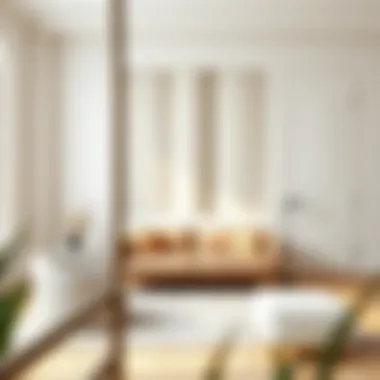

Faux wall room dividers shine brightly in the world of events, offering solutions for both large gatherings and intimate settings. When hosting a wedding or corporate function, organizers can effortlessly create unique spaces or zones using lightweight dividers. With fabric dividers, event planners can add colors and textures that align with the theme of the occasion, from elegant soft drapes for a wedding to bold patterns for a corporate bash.
- Quick Assembly: Easier to set up and dismantle compared to permanent installations.
- Transformative Spaces: They quickly alter a room atmosphere, catering to various elements of an event.
- Cost-Effective: Renting dividers can reduce overall costs while still achieving desired layouts.
"Faux wall room dividers are not just functional; they’re transformative in the way they adapt to the needs of diverse spaces."
In summary, whether in homes, businesses, or event spaces, the applications for faux wall room dividers are extensive and dynamic. They not only provide a practical solution to space management but also enrich the overall aesthetic quality of any environment.
Cost Analysis of Faux Wall Room Dividers
In the world of home décor and interior design, the financial implications of adding new features to your spaces can’t be overstated. Understanding the cost associated with faux wall room dividers is pivotal for homeowners, designers, retailers, and DIY enthusiasts alike. With the ability to modify spaces creatively and practically, these dividers offer a dynamic solution that caters to various needs. But beyond their aesthetic appeal and functional advantages, a cost analysis can illuminate the true value these elements bring.
Evaluating costs isn’t just about the price tag at the time of purchase. It's about weighing that initial investment against the long-term benefits these dividers provide, not to mention the overall impact on your living or working environment.
Initial Investment vs. Long-term Benefits
When pondering the introduction of faux wall room dividers into your space, it’s essential to take a gander at the initial costs involved. Depending on the type, quality, and design of the divider, prices can fluctuate vastly. Faux wood dividers, for instance, may cost more upfront compared to basic fabric options.
To illustrate:
- Faux Wood Dividers: Ranging from $150 to $800 depending on the brand and finish.
- Faux Glass Dividers: Often start around $200 and can soar to over $1,000 for more intricate designs.
- Fabric and Textile Dividers: Generally, these are the most budget-friendly, often falling between $50 to $300.
However, it’s crucial to not just focus on that immediate expense. Think of how these dividers can transform spaces, manage sound, and even provide privacy. For example, in a home office setting, a faux divider can help minimize distractions, leading to increased productivity. Now, if that boost in productivity translates into a better work performance that earns you more money, then suddenly that perceived high cost doesn’t seem so high, does it?
When considering longevity, materials play an integral role. Many faux wall dividers are designed to last, resisting wear and tear better than traditional partitions. Adding a smart divider today might save you from needing renovations just a few years down the line. Over time, you might find that the investment in faux wall dividers not only pays for itself but also enhances your property’s value.
Budget-Friendly Options
In the vast realm of faux wall room dividers, there’s something for everyone—even those on a tight budget. Finding a balance between quality and affordability is key. Here are some budget-friendly options worth your consideration:
- DIY Faux Dividers: With a splash of creativity, you can craft your divider using inexpensive materials such as plywood or even repurposed items like old doors.
- Fabric Screens: Products like room divider curtains or lightweight fabric panels can range from $20 to $100, providing flexibility without breaking the bank.
- Modular Systems: Some brands offer modular systems that allow you to customize dividers according to your needs, making it possible to expand or reduce your divider setups easily.
- Secondhand Finds: Check out local thrift stores or online marketplaces for used dividers. You might be surprised at the treasures you could discover at a fraction of the original price.
When hunting for cheap yet visually appealing options, remember to focus on functionality as well. A lower price shouldn’t equate to lower quality; the goal is to find dividers that fulfill your needs at an affordable price.
In sum, the cost analysis of faux wall room dividers is multi-faceted. It encompasses not just the initial purchase but also considers the broader implications regarding space transformation, aesthetic additions, and long-term value. With thoughtful planning and informed budgeting, faux wall dividers can be both feasible and beneficial additions to any space.
"Budget constraints can often lead to the most inventive solutions in design."
For further insights on economical yet stylish interior solutions, you might explore resources such as The Spruce or even community-driven insights on Reddit.
Ultimately, aligning your budget with your design dreams doesn’t have to be a Herculean task.
Trends in Faux Wall Room Dividers
The landscape of faux wall room dividers is ever-evolving, with contemporary trends reflecting a blend of innovation, style, and functionality. This section dives into the prominent trends shaping the market today, emphasizing the key elements and benefits they bring to both residential and commercial spaces. As homeowners and designers continue to seek versatile solutions for space management, understanding these trends is essential for making informed choices about faux wall dividers.
Emerging Designs in Contemporary Decorating
In recent years, minimalism and sustainability have taken center stage in interior design, leading to a rise in faux wall room dividers that embody these principles. Homeowners increasingly favor clean lines, neutral palettes, and repurposed materials, which are easier to integrate into existing décor. For instance, dividers designed with reclaimed wood not only add uniqueness but also tell a story, resonating with environmentally-conscious clients.
Moreover, modular designs are gaining traction, allowing for customized layouts that can be adapted as needs change. These pieces often feature geometric patterns or multi-functional attributes, enabling users to switch between open and closed spaces fluidly. This adaptability is particularly beneficial in collaborative workspaces, providing both privacy and openness as required.
One eye-catching trend is the incorporation of organic shapes, straying from traditional angular constructions. Curved dividers soften the aesthetic of a room and invite a more relaxed atmosphere, appealing to those aiming for a cozy, welcoming environment.
"As spaces continue to adapt to varied functions, the designs of faux wall dividers evolve to meet those needs, making them not just dividers, but an integral part of the interior narrative."
Integration of Smart Technology
As technology permeates every aspect of modern living, the world of faux wall room dividers is not left behind. The integration of smart technology into these structures offers new dimensions to their functionality. For example, certain dividers now come equipped with built-in smart lighting systems. These can set the mood with adjustable brightness or color change options, directly controlled via a smartphone app.
Moreover, acoustic panels, often embedded within these dividers, leverage advanced soundproofing technology to enhance privacy and reduce noise pollution. This adaptation is particularly valuable for urban residents where liveliness can often encroach upon personal space.
The advancement of smart features also includes technology for remote control over elements of the divider, like its height or opacity, allowing users to modify their environment at the push of a button. Such features cater to individuals who require adaptability in their spaces, whether for hosting, working, or relaxation purposes.
Closure
The role of faux wall room dividers in today’s living spaces cannot be overstated. These innovative solutions not only offer aesthetic enhancements, but they also cater to the fluctuating needs of homeowners, commercial establishments, and event organizers alike. In an era where space optimization calls for creativity, faux wall dividers stand out as a perfect blend of style and functionality.
Summary of Key Insights
Throughout this guide, we have explored various dimensions of faux wall room dividers. Key insights include:
- Variety of Formats: Faux wall dividers come in numerous types including faux wood, glass, and fabric. Each type serves unique purposes that align with diverse design preferences and practical requirements.
- Material Selection: An emphasis on sustainable materials showcases the industry's shift towards eco-friendliness, while innovative composites offer durability and style without heavy maintenance burdens.
- Flexible Application: These dividers are adaptable to different settings, proving beneficial in both residential and commercial spaces as well as for temporary solutions in events.
- Cost vs. Value: An informed cost analysis reveals that while the initial investment might seem significant, the long-term benefits in terms of adaptability and space management maximize the return on investment.
These insights solidify the practicality of faux wall room dividers as a viable solution for modern interior design challenges.
Final Thoughts on Implementation
As one contemplates the implementation of faux wall room dividers, a few considerations emerge:
- Understanding the Space: Assessing the layout and purpose of the area is crucial. It allows for an informed decision on which divider will best suit the needs of the users.
- Design Traits: Color schemes and patterns must align with existing decor. An ill-matched divider can disrupt the harmony of a space.
- Maintenance and Care: Choosing the right type of material out of the gate can save time and effort in upkeep down the line. Instructions regarding care are typically provided by manufacturers and shouldn’t be overlooked.
- Consultation: Engaging with interior designers can bring professional insights that may tailor the divider experience to specific needs.
- Experimentation: Lastly, don’t shy away from trying something new! The flexibility of faux wall dividers allows for experimentation — should you want to change the mood of a room down the road, a simple rearrangement or replacement might do the trick.
By taking these elements into account, the installation and use of faux wall room dividers can transform spaces into stylish, functional environments that resonate with today’s design philosophies.





